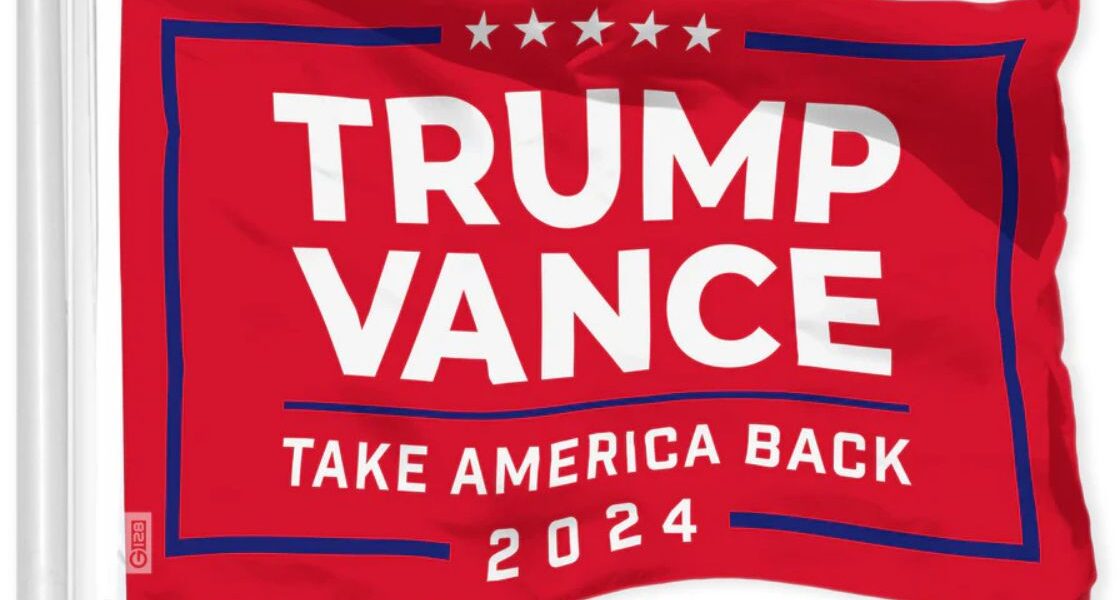The “Trump Vance Flag” has become a notable symbol, embodying a fusion of political ideologies, personalities, and regional pride. This flag, which combines elements of both former President Donald Trump’s political legacy and the political aspirations of Ohio Senate candidate J.D. Vance has sparked significant discussion. Understanding the flag’s design, its political roots, and the controversy surrounding it provides insight into the current state of American politics and the ways in which symbols are used to convey political messages.
The Design of the Trump Vance Flag
At its core, the Trump Vance Flag is a simple yet striking visual. It merges the familiar red, white, and blue of the American flag with personalized elements to emphasize the connection between Trump’s populist political movement and Vance’s campaign. The flag prominently displays Trump’s name alongside Vance’s, creating a blend of national and local pride.
What sets this flag apart from other political flags, like the “Trump 2020” flag, is the combination of Trump’s well-established brand with the rising political career of J.D. Vance, who gained national attention for his book Hillbilly Elegy. His political stance, strongly supportive of Trump’s populist agenda, led him to run for the Senate in Ohio in 2022. The flag visually represents their alignment, aimed at reinforcing their shared values and commitment to the working-class voter.
The Political Message Behind the Flag
The Trump Vance Flag is a powerful symbol for a specific political demographic. Conservative, working-class voters who feel disillusioned with the establishment. Trump, who built his political identity on anti-establishment rhetoric, has become a figurehead for those who see themselves as politically neglected by traditional politicians. Vance, who initially critiqued Trump during the 2016 election. Transformed his stance to align with the former president’s views, particularly after securing Trump’s endorsement in his Senate bid.
For Vance, the flag is more than just a symbol of political alignment; it represents a strategic move to appeal to Trump’s base, which remains incredibly influential in American politics. By aligning himself with Trump so visibly, Vance signals his commitment to the former president’s agenda and to the people who support it.
Regional Pride and the Ohio Connection
Ohio, as a battleground state, has historically been a key swing state in national elections. The Trump Vance Flag also serves as a visual representation of the state’s central role in American politics. Vance, who grew up in Ohio, has built his campaign narrative around the idea of restoring the American dream, particularly for working-class people in the Rust Belt.
By incorporating the Trump legacy into his campaign, Vance aims to capitalize on the state’s deep-seated conservative values while also echoing Trump’s messages on economic nationalism and immigration. The flag’s usage within Ohio during Vance’s campaign underscores his desire to retain Ohio’s red state status and to further entrench the Republican Party’s dominance there.
For many of Vance’s supporters, the flag represents a return to traditional American values. With an emphasis on economic revitalization for working-class Americans. The flag’s symbolism draws on the idea that Trump and Vance together can champion the cause of those who feel left behind by the global economy.
Controversy and Criticism
The Trump Vance Flag has not been without its controversies. Critics of Vance, particularly those on the political left, view the flag as a symbol of divisiveness. Underscoring the tensions between the progressive and conservative factions of American society. The flag is seen by some as a rallying point for the far-right and for those who are nostalgic for Trump’s combative style of politics.
Some have also criticized the flag for its overtly populist undertones. Which they argue exploit economic anxiety and the fears of working-class voters for political gain. They see it as an attempt to distract from real issues. Such as economic inequality, healthcare, and climate change, by creating a “us vs. them” narrative that targets elites and immigrants. A shift that relies heavily on strong, easily recognizable symbols to unify a particular group of people.
Moreover, there are those who believe that Vance’s alignment with Trump, symbolized by the flag, is a political opportunism rather than a genuine alignment of ideologies. Vance, who once criticized Trump in his early years, is accused of embracing Trump’s support only for political gain, leading to accusations of hypocrisy. This dissonance is a recurring theme in the political careers of several figures who initially distanced themselves from Trump, only to embrace him when it became politically advantageous.
Conclusion: The Legacy of the Trump Vance Flag
In the context of modern American politics, the Trump Vance Flag represents more than just a campaign emblem. It serves as a potent reminder of the current political climate, one where symbols and slogans hold as much. If not more, power than policies themselves. Whether seen as a symbol of political unity or as an emblem of division, the flag has earned its place in the ongoing political discourse surrounding populism, identity, and the future direction of American politics.





